Description
Upperside. Antennae black. Front of the head yellow. Thorax black, with two yellow streaks at the base of the wings. Abdomen dark brown. Half of the superior wings black, beginning at the shoulders, and running to the external edges, on which are seven cream-coloured spots variously shaped. The other half of these wings is scarlet, without any marks. Posterior wings entirely scarlet, edged with black.
Underside. Palpi cream coloured. Breast and abdomen light yellow. Legs black, but underneath pale yellow. Wings coloured as on the upperside. Margins of the wings entire. Wingspan 1+1⁄4 inches (33 mm). [1]

Curoba is a monotypic moth genus in the subfamily Arctiinae erected by Francis Walker in 1865. It contains the single species Curoba sangarida, first described by Caspar Stoll in 1782, which is found in southern India and Sri Lanka.
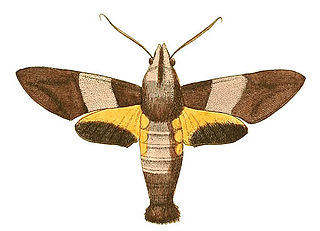
Macroglossum passalus, the black-based hummingbird hawkmoth, is a moth of the family Sphingidae described by Dru Drury in 1773. It is known from Sri Lanka, India, Thailand, south-eastern China, Taiwan, southern Japan, Indonesia and the Philippines.

Dactyloceras lucina is a species of very large moth of the family Brahmaeidae. It is found in central and west Africa, where it has been recorded from Equatorial Guinea, Ghana, Ivory Coast, Kenya, Sierra Leone, Uganda and Zambia. The species was first described by Dru Drury in 1782.

Pseudacraea hostilia, the western incipient false acraea, is a butterfly in the family Nymphalidae. It is found in Sierra Leone, Liberia, Ivory Coast and western and central Ghana. The habitat consists of wetter forests.
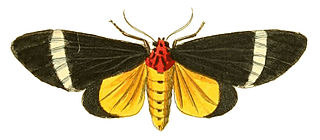
Caryatis phileta is a moth of the subfamily Arctiinae. It was described by Dru Drury in 1782. It is found in Cameroon, the Democratic Republic of the Congo, Gabon, Ghana, Nigeria and Sierra Leone.

Eudesmia menea, the lunar eudesmia, is a moth of the subfamily Arctiinae. It was described by Drury in 1782. It is found from Brazil and Colombia, through Central America, to the southern United States, where it is found from southern Texas to Florida.

Colla rhodope is a moth in the family Bombycidae. It was described by Dru Drury in 1782. It is found from Mexico to Colombia, Ecuador and Brazil.

Antheua servula is a species of moth of the family Notodontidae. It was first described by Dru Drury in 1773 from Madras. It is also found in other parts of India, Sri Lanka and on Sumatra.

Crameria is a monotypic moth genus in the family Noctuidae erected by Jacob Hübner in 1819. Its only species, Crameria amabilis, was first described by Dru Drury in 1773.

Euglyphis rivulosa is a species of moth in the family Lasiocampidae. It was first described by Dru Drury in 1773 from Suriname.

Tifama is a monotypic moth genus in the family Notodontidae erected by Francis Walker in 1855. Its only species, Tifama chera, was first described by Dru Drury in 1773. The species is known from Suriname and Brazil.

Otroeda cafra is a species of moth in the tussock-moth subfamily Lymantriinae. It was first described by Dru Drury in 1782 from Sierra Leone, and is also found in Cameroon, DR Congo, Malawi, and Nigeria.

Otroeda nerina is a species of moth in the tussock-moth subfamily Lymantriinae. It was first described by Dru Drury in 1782 from Sierra Leone, and is also found in Cameroon, DR Congo, Gabon, Ghana and Nigeria.

Catonephele acontius, the Acontius firewing, is a nymphalid butterfly species found in South America. It was first described by Carl Linnaeus in 1771.

Panara jarbas is a species in the butterfly family Riodinidae found in Brazil. It was first described by Dru Drury in 1782.

Anteros acheus is a species of butterfly of the family Riodinidae, found in Brazil, Suriname and Bolivia. It was first described by Caspar Stoll in 1781.
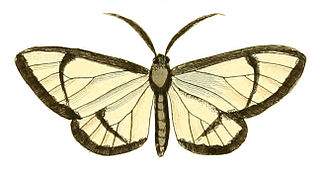
Locha hyalina is a moth species in the family Geometridae from Central and parts of South America. It was described by Dru Drury in 1782, but his name Phalaena diaphana was invalid as pre-occupied.

Zamarada eucharis is a species of moth in the family Geometridae. It was first described by Dru Drury in 1782, from Sierra Leone. It is found in Ivory Coast, Ghana, Guinea, Liberia and Sierra Leone
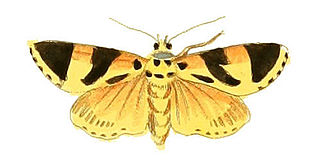
Attatha ino is a species of moth of the family Noctuidae. It was described by Dru Drury in 1782 from "Madras".
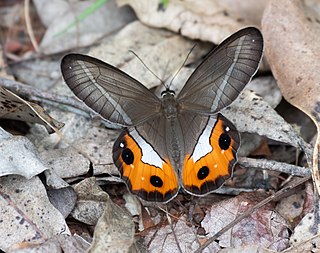
Pierella nereis is a butterfly species from the subfamily Satyrinae in the family Nymphalidae. It was first described by Dru Drury in 1782 from Brazil.




















